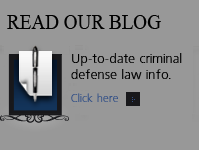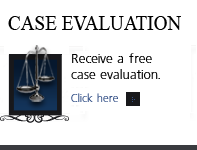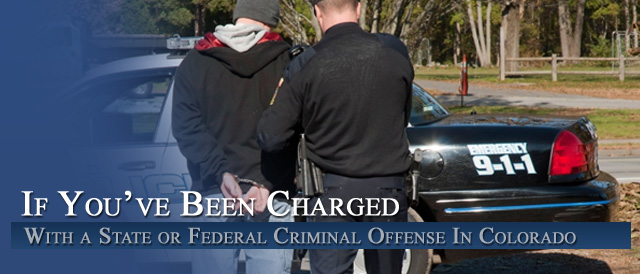

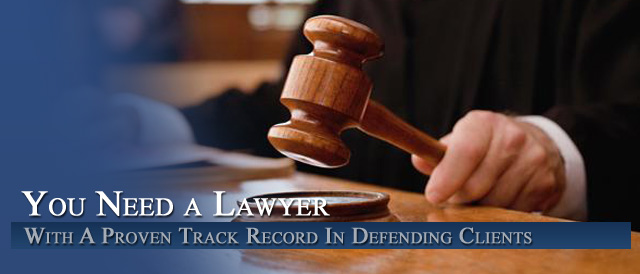
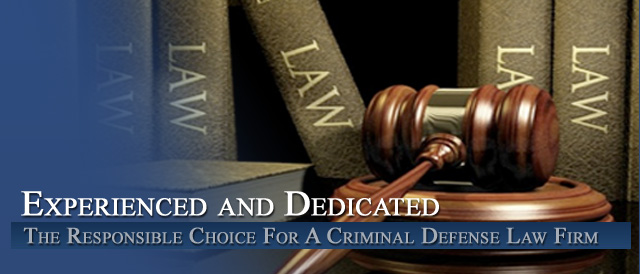
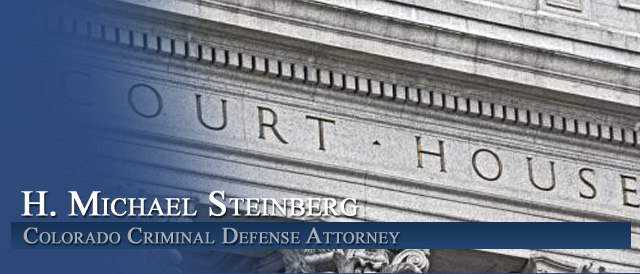
When The Denver Police Seize Your Property As A Public Nuisance
By H. Michael Steinberg Colorado Criminal Defense Lawyer – Attorney
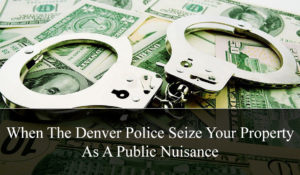 When The Denver Police Seize Your Property As A Public Nuisance – One of the most shocking powers of the City of Denver is the authority to seize your personal property as a Public Nuisance – something called Nuisance Abatement.
When The Denver Police Seize Your Property As A Public Nuisance – One of the most shocking powers of the City of Denver is the authority to seize your personal property as a Public Nuisance – something called Nuisance Abatement.
While I have written on this public nuisance forfeiture subject before – I intend this article to further explore the laws that are so blatantly used to harm the people of Colorado. Only a thorough analysis of the Colorado Forfeiture Law – gives us the answers as to how this Draconian process is used to take personal property – sometimes under circumstances of the most unfair and unjust kind.
Abating A Public Nuisance – What Does That Mean?
The following is actually taken from the Denver Police Department Policy Manual:
104.53 Nuisance Abatement
(1) It is the policy of the Denver Police Department that real property and vehicles upon which
Public Nuisance activity, as defined by Denver Revised Municipal Code (D.R.M.C) section 37-50 and C.R.S. §16-13-303, is occurring be investigated using sound investigative practices, in a manner consistent with the goal of abating the activity.
In the city of Denver nuisance abatement proceedings can be conducted by the Denver City Prosecutor or The Denver District Attorney.
The Denver City Prosecutor calls the practice nuisance abatement – the DA calls the procedure asset forfeiture.
The Denver DA begins the asset forfeiture when the police investigation ends. The DA does NOT have to wait until the “connected” criminal prosecution has been completed. There is not only no requirement that a case be prosecuted – in many instances a criminal case is never filed and the asset forfeiture or nuisance abatement is the ONLY punishment inflicted on the offender.
I repeat – because it may comes as a surprise to many – no conviction is necessary for an abatement or forfeiture. The owner or the seized and forfeited property may never be charged with any criminal offense.
To Make This Very Real – The Following Nuisance Abatement Policies Are Taken Out Of The Denver Police Department Manual
Asset Seizure and Forfeiture In Denver Colorado
The Denver District Attorney’s Office, “Property Confiscation Division” is responsible for filing forfeiture actions. The Denver District Attorney’s Office, Property Confiscation Division shall provide guidance during all phases of forfeiture actions.
Types of property subject to confiscation: (Generally, the minimum value of property submitted for a forfeiture filing must be $1000.00 or more)
1. Money: Currency and other financial assets which are proceeds of a crime, or intended to be used to facilitate a crime (e.g. bank accounts, CD’s, stocks, savings bonds and etcetera).
2. Real estate: May include houses, condominiums, town homes, businesses, etcetera, as well as the building’s fixtures and contents.
3. Vehicles: Those used in the commission of the crime, conducting, maintaining, aiding, or abetting the criminal activity, or which are proceeds of the crime.
4. Personal property: Items used in conducting, maintaining, aiding, or abetting the criminal activity, or which are proceeds of the crime; bought with money earned from the crime (e.g. computers, high-end television sets, electronic equipment, bicycles and etcetera).
Crimes for which property can be confiscated.
Class 1 Public Nuisance (C.R.S. §16-13-303)
a. There must be proof by clear and convincing evidence the property to be forfeited was “instrumental” (i.e. a substantial connection between the property to be seized and the crime committed ) in the commission or facilitation of a crime creating a public nuisance or the property constitutes traceable proceeds of the crime or related criminal activity.
b. For property to be forfeited, the law generally requires an owner of the property had knowledge or notice of the criminal activity, or prior similar activity.
How Is The Nuisance Abatement Accomplished In Court?
The lawsuit to abate a nuisance and to seize property is a civil action brought – in most cases – by the City of Denver pursuant to the Public Nuisance Statute, sections 16-13-301 to -316, C.R.S..
An example of the most egregious of this kind of civil suit is an action to take a person’s house because of a connection between the home and the sale of controlled substances.
A civil “complaint” is filed which charges that the Defendant used the real and personal property, the subject matter of the action, to facilitate the unlawful sale, distribution, storage, and possession of a Schedule II controlled substances in violation of sections 18-18-103 and 18-18-106,.
The complaint in a drug related civil nuisance abatement case will state that the home is owned by persons who had knowledge as to the illegal use of their home and that this “created” a class 1 nuisance.
Colorado’s Public Nuisance Statute – 16-13-303 provides that:
“Every public nuisance shall be restrained, prevented, abated, and perpetually enjoined.”
Section 16-13-303 further provides:
Class 1 public nuisance. (1) Every building or part of a building including the ground upon which it is situate and all fixtures and contents thereof, every vehicle, and any real property shall be deemed a class 1 public nuisance when:
[HMS – what follows in the law is a long list of crimes for which a building (e.g. a home) can be seized and forfeited as a “public nuisance.” Here is the list:]
[Prostitution] – (a) Used as a public or private place of prostitution or used as a place where the commission of soliciting for prostitution, as defined in section 18-7-202, C.R.S.; pandering, as defined in section 18-7-203, C.R.S.; keeping a place of prostitution, as defined in section 18-7-204, C.R.S.; pimping, as defined in section 18-7-206, C.R.S.; or human trafficking, as described in section 18-3-503 or 18-3-504, C.R.S., occurs;
[Gambling] – (b)(I) Used, or designed and intended to be used, as gambling premises, as defined in section 18-10-102(5), C.R.S., or as a place where any gambling device or gambling record, as such terms are defined in section 18-10-102(3) and (7), C.R.S., is kept;
(II) Used for transporting gambling proceeds, records, or devices as defined in section 18-10-102(3), (6), and (7), C.R.S.;
[Drugs] – (c)(I) Used for unlawful manufacture, cultivation, growth, production, processing, sale, or distribution or for storage or possession for any unlawful manufacture, sale, or distribution of any controlled substance, as defined in section 18-18-102(5), C.R.S., or any other drug the possession of which is an offense under the laws of this state, or any imitation controlled substance, as defined in section 18-18-420(3), C.R.S.;
(II) Used for unlawful possession of any controlled substance, as defined in section 18-18-102(5), C.R.S., except for possession of less than sixteen ounces of marijuana;
[General Class 1 Public Nuisance] – (d) Used for a purpose declared by a statute of this state to be a class 1 public nuisance;
[Theft] – (e)(I) Used as a place where the commission of theft, as specified in section 18-4-401, C.R.S., occurs; (II) Used for transporting property which is the subject of theft, as specified in section 18-4-401, C.R.S.;
[Drug Paraphenalia] – (f) Used for the unlawful manufacture, sale, or distribution of drug paraphernalia, as defined in section 18-18-426, C.R.S.;
[Prostitution of a Child] – (g) Used for prostitution of a child, as defined in section 18-7-401, C.R.S., or used as a place where the commission of soliciting for child prostitution, as defined in section 18-7-402, C.R.S., pandering of a child, as defined in section 18-7-403, C.R.S., keeping a place of child prostitution, as defined in section 18-7-404, C.R.S., pimping of a child, as defined in section 18-7-405, C.R.S., or inducement of child prostitution, as defined in section 18-7-405.5, C.R.S., occurs;
[Exploitation of Children] – (h) Used for the sexual exploitation of children pursuant to part 4 of article 6 of title 18, C.R.S.;
[Transportation Laws] – (h.6) Used in violation of section 43-10-114, C.R.S.;
[ANY FELONY] – (i) Used in the commission of any felony not otherwise included in this section;
[Vehicular Eluding] – (j) Used in the commission of felony vehicular eluding pursuant to section 18-9-116.5, C.R.S.;
[Hit and Run With Serious Bodily Injury Or Death] – (k) Used in the commission of hit and run with serious bodily injury or death pursuant to section 42-4-1601(1), (2)(b), and (2)(c), C.R.S.;
[A Drive By Crime] – (l) Used in committing a drive-by crime, as defined in section 16-13-301(2.2);
[Gaming Place] – (m)(I) Used, or designed and intended to be used, as gaming premises, or as a place where any gaming device, as such term is defined in section 12-47.1-103(10), C.R.S., or gaming record is kept, in violation of article 47.1 of title 12, C.R.S., or in violation of article 20 of title 18, C.R.S.;
(II) Used for transporting adjusted gross proceeds or gaming devices as such terms are defined in section 12-47.1-103(1) and (10), C.R.S., or records in violation of the provisions of article 47.1 of title 12, C.R.S., or in violation of article 20 of title 18, C.R.S.;
[Gaming] – (III) Used for the unlawful manufacture, production, sale, distribution, or for storage or possession for any unlawful manufacture, sale, or distribution of any gaming device, as defined in section 12-47.1-103(10), C.R.S., or any other gaming device, equipment, key, electronic or mechanical device, slot machine, bogus chips, counterfeit chips, cards, coins, gaming billets, cheating device, thieving device, tools, drills, or wires used in violation of article 47.1 of title 12, C.R.S., or in violation of article 20 of title 18, C.R.S.; ?or
[Crimes Against The Elderly] – (n) Used in committing, attempting to commit, or conspiring to commit against an elderly person any felony set forth in part 4 of article 4 of title 18, C.R.S., in part 1, 2, 3, or 5 of article 5 of title 18, C.R.S., article 5.5 of title 18, C.R.S., or section 11-51-603, C.R.S. For purposes of this paragraph (n), an “elderly person” means a person sixty years of age or older.
[Crimes By Telemarketers] – (1.5) All equipment, mechanical systems, or machinery, or parts thereof, shall be deemed to be a class 1 public nuisance at the location of the automatic dialing system when used for soliciting with an automatic dialing system containing a prerecorded message in violation of section 18-9-311(1), C.R.S.
[HMS – the law – section (2) then describes what can be seized and forfeited – (essentially everything!)]
(2) All fixtures and contents of any building, structure, vehicle, or real property which is a class 1 public nuisance under subsection (1) of this section and all property which is a class 1 public nuisance under subsection (1.5) of this section are subject to seizure, confiscation, and forfeiture as provided in this part 3. In addition, the personal property of every kind and description, including currency and other negotiable instruments and vehicles, used in conducting, maintaining, aiding, or abetting any class 1 public nuisance is subject to seizure, confiscation, and forfeiture, as provided in this part 3.
(3) The following shall be deemed class 1 public nuisances and be subject to forfeiture and distributed as provided in section 16-13-311(3), and no property rights shall exist in them:
(a) All currency, negotiable instruments, securities, or other things of value furnished or intended to be furnished by any person in exchange for any public nuisance act; or
(b) All proceeds traceable to any public nuisance act; or
(c) All currency, negotiable instruments, and securities used or intended to be used to facilitate any public nuisance act; or
(d) All equipment of any kind, including but not limited to computers and any type of computer hardware, software, or other equipment, used in committing sexual exploitation of a child, as described in section 18-6-403, C.R.S., or computer crime, as described in section 18-5.5-102, C.R.S.
[HMS – Section (4) allows the seizure of profits called “proceeds” from the public nuisance.]
(4) Whenever it is established, in an action brought pursuant to this part 3, that a person has received proceeds derived from any public nuisance act, the court shall award to the plaintiff a money judgment of forfeiture for the amount of said proceeds shown to have been derived from any public nuisance act or for an amount shown to have been derived from a series of similar acts which fall within a pattern of public nuisance acts. The person subjected to such a money judgment may claim a setoff equal to the fair market value of the property forfeited if he shows that said property is traceable to the public nuisance act upon which the money judgment is predicated.
[HMS – Section 5(a) requires the government to prove the person whose property is being seized and forfeited is the “true owner” of the property.]
(5)(a) In any action seeking forfeiture of property pursuant to this part 3, any person contesting the forfeiture shall establish by a preponderance of the evidence such person’s standing as a true owner of the property or a true owner with an interest in the property.
(b) To establish standing, the person shall first prove that the person had a recorded or registered interest in the property, or a bona fide marital interest in the property, prior to title-vesting in the state, if the property is of the type for which interests can be, and customarily are, recorded or registered in a public office.
(c) The person shall also prove that he or she is a true owner of the property or a true owner of an interest in the property.
The factors to be considered by the court in determining whether a person is a true owner shall include, but need not be limited to:
(I) Whether the person had the primary use, benefit, possession, or control of the property;
(II) How much of the consideration for the purchase or ownership of the property was furnished by the person, and whether the person furnished reasonably equivalent value in exchange for the property or interest;
(III) Whether the transaction by which the person acquired the property or interest was secret, concealed, undisclosed, hurried, or not in the usual mode of doing business;
(IV) Whether the transaction by which the person acquired the property or interest was conducted through the use of a shell, alter ego, nominee, or fictitious party;
(V) Whether the person is a relative, a co-conspirator, complicitor, or an accessory in the public nuisance act or acts or other criminal activity, a business associate in a legal or illegal business, one who maintains a special or close relationship with, or an insider with respect to the perpetrator of the alleged public nuisance act or acts;
(VI) Whether the person is silent or fails to call parties to testify or to produce available evidence explaining the acquisition of the property or factors which may be badges of fraud or deceit, or show lack of true ownership;
(VII) Whether the timing of the transaction by which the person acquired the property was during the pendency or threat of litigation, or during any time when the person knew, should have known, or had notice of the public nuisance act or acts or the threat of a forfeiture action;
(VIII) Whether the placing of the title in the name of, or the putative ownership in, or transfer to, the person was done with intent to delay, hinder, or avoid a forfeiture, or for some purpose other than ownership of the property;
(IX) Whether the perpetrator of the alleged public nuisance act or acts has absconded or is a fugitive from justice and the conveyance occurred after the flight, or before the flight, in any of the circumstances set forth in subparagraph (III) of this paragraph (c);
(X) Whether the subject matter property is of a kind in which property or ownership rights can legally exist;
(XI) Any other badge or indicia of fraud under article 8 of title 38, C.R.S., or the general law of fraudulent transfers or conveyances.
(d) The court shall consider the totality of the circumstances in determining whether a person is a true owner. A person contesting the forfeiture does not necessarily have to show that all of the factors enumerated in paragraph (c) of this subsection (5) support the claim of true ownership, nor does the person necessarily establish true ownership by showing the absence of fraudulent intent or badges of fraud.
(e) No private sale or conveyance of a used motor vehicle shall be deemed to make a party eligible to assert standing to contest the forfeiture thereof, unless the title to the motor vehicle, with transfer duly executed to the party, has been filed with the division of motor vehicles in the department of revenue prior to the physical seizure of the vehicle and the recording of a notice of seizure, or the party attempting to assert standing has exclusive possession of the vehicle at the time of seizure. A party eligible to assert standing under this paragraph (e) must nevertheless establish that the party is a true owner of the vehicle or has an interest therein pursuant to paragraph (c) of this subsection (5).
(f) Unless the standing of a particular party is conceded in the complaint initiating the public nuisance action, a party must assert standing in the answer and fully describe the party’s interest in the property which is the subject matter of the action, and submit a verified statement, supported by any available documentation, of the party’s ownership of or interest in the property.
[HMS – Section 5.1(a) specifies the burden of proof (clear and convincing evidence) on the government to prove that the possession of the property is unlawful or that the owner of the property was a party to the creation of the public nuisance… and that that the property was instrumental in the commission or facilitation of a crime creating a public nuisance or the property constitutes traceable proceeds of the crime or related criminal activity.
(5.1)(a) In any action to forfeit property pursuant to this part 3, the plaintiff, in addition to any other matter which must be proven in the plaintiff’s case in chief, shall prove by clear and convincing evidence that possession of the property is unlawful or that the owner of the property was a party to the creation of the public nuisance. The plaintiff shall also prove by clear and convincing evidence that the property was instrumental in the commission or facilitation of a crime creating a public nuisance or the property constitutes traceable proceeds of the crime or related criminal activity.
[HMS – This important Section (a.5)(1) provides a right to challenge a forfeiture based on proportionality – that is – the Defendant can argue that the seizure was unconstitutional based on basic fairness issues…]
(a.5)(I) The defendant in an action brought pursuant to this part 3 may petition the court to determine whether a forfeiture was constitutionally excessive. Upon the conclusion of a trial resulting in a judgment of forfeiture in an action brought pursuant to this part 3, if the evidence presented raises an issue of proportionality under this paragraph (a.5), the defendant may petition the court to set a hearing, or the court may on its own motion set a hearing, to determine whether a forfeiture was constitutionally excessive. This determination shall be made prior to any sale or distribution of forfeited property.
(II) In making this determination, the court shall compare the forfeiture to the gravity of the public nuisance act giving rise to the forfeiture and related criminal activity.
(III) The defendant shall have the burden of establishing by a preponderance of the evidence that the forfeiture is grossly disproportional.
(IV) If the court finds that the forfeiture is grossly disproportional to the public nuisance act and related criminal activity, it shall reduce or eliminate the forfeiture as necessary to avoid a violation of the excessive fines clause of the eighth amendment of the United States constitution or article II, section 20, of the Colorado constitution.
[HMS – This next section addresses the knowledge requirement that must be established to link the owner of property to the acts creating the public nuisance. If the state can prove this link – the Defendant can then prove that he or she took reasonable steps to prohibit or abate the unlawful use of the property for the court to find the owner was not a party to the creation of the public nuisance.]
(b) As used in paragraph (a) of this subsection (5.1), an owner was a “party to the creation of the public nuisance” if it is established that:
(I) The owner was involved in the public nuisance act; or
(II)(A) The owner knew of the public nuisance act or had notice of the acts creating the public nuisance or prior similar conduct.
(B) Notwithstanding the provisions of sub-subparagraph (A) of this subparagraph (II), if the plaintiff proves by clear and convincing evidence the owner knew or had notice of the public nuisance, the owner must prove by a preponderance of the evidence that the owner took reasonable steps to prohibit or abate the unlawful use of the property for the court to find the owner was not a party to the creation of the public nuisance.
[HMS – Section (5.2)(a) provides for the most important Defense to a nuisance abatement called the “Innocent Owner Defense”]
(5.2)(a) With respect to a partial or whole ownership interest in existence at the time the conduct constituting a public nuisance took place, “innocent owner” means any owner who:
(I) Did not have actual knowledge of the conduct constituting a public nuisance, or notice of an act or circumstance creating the public nuisance or prior similar conduct, notice being satisfied by, but not limited to, sending notice of an act or circumstance creating the public nuisance by certified mail; or
(II) Upon learning of the conduct constituting a public nuisance, took reasonable action to prohibit such use of the property. An owner may demonstrate that he or she took reasonable action to prohibit the conduct constituting a public nuisance if the owner:
(A) Timely revoked or attempted to revoke permission for the persons engaging in such conduct to use the property; or
(B) Took reasonable action to discourage or prevent the use of the property in conduct constituting a public nuisance.
(b) With respect to a partial or whole ownership interest acquired after the conduct constituting a public nuisance has occurred, “innocent owner” means a person who, at the time he or she acquired the interest in the property, had no knowledge or notice that the illegal conduct subjecting the property to seizure had occurred or that the property had been seized for forfeiture, and:
(I) Acquired an interest in the property in a bona fide transaction for value; or
(II) Acquired an interest in the property through probate or inheritance; or
(III) Acquired an interest in the property through dissolution of marriage or by operation of law.
(c) An innocent owner’s interest in property shall not be forfeited under any provision of state law. An innocent owner has the burden of proving by a preponderance of the evidence that he or she has an ownership interest in the subject property. Otherwise, the burden of proof under this subsection (5.2) shall be as provided in subsection (5.1) of this section.
(d) A person who is convicted of a criminal offense arising from the same activity giving rise to the forfeiture proceedings in accordance with section 16-13-307(1.5) shall not be eligible to assert an innocent owner defense.
[HMS – When Currency is seized – there is a rebuttable presumption that the currency was from illegal profits – making it harder to defeat the State’s case.]
(6) Whenever clear and convincing evidence adduced in an action pursuant to this part 3 shows a substantial connection between currency and the acts specified in subparagraph (I) of paragraph (c) of subsection (1) of this section, a rebuttable presumption shall arise that said currency is property subject to forfeiture.
A substantial connection exists if:
(a) Currency in the aggregate amount of one thousand dollars or more was seized at or close to the time that evidence of the acts specified in subparagraph (I) of paragraph (c) of subsection (1) of this section was developed or recovered; and
(b)(I) Said amount of currency was seized on the same premises or in the same vehicle where evidence of said acts was developed or recovered; or
(II) Said amount of currency was seized from the possession or control of a person engaged in said acts; or
(III) Traces of a controlled substance were discovered on the currency or an animal trained in the olfactory detection of controlled substances indicated the presence of the odor of a controlled substance on the currency as testified to by an expert witness.
(6.5) Notwithstanding any other provision of this part 3 to the contrary, the plaintiff shall have the burden of proving, by clear and convincing evidence, only the facts that give rise to the presumption that currency is property subject to forfeiture pursuant to subsection (6) of this section.
However, when a preponderance of credible evidence is adduced to rebut a presumption that has arisen pursuant to subsection (6) of this section, the burden of proof shall revert to the plaintiff to prove, by clear and convincing evidence, the elements of the plaintiff’s case with respect to the currency.
(7) Currency seized pursuant to this part 3 may be placed in an interest-bearing account during the proceedings pursuant to this part 3 if so ordered by the court upon the motion of any party. Photocopies of portions of the bills shall serve as evidence at all hearings. The account and all interest accrued shall be forfeited or returned to the prevailing party in lieu of the currency.
(8) The provisions of subsection (6) of this section shall not be construed so as to limit the introduction of any other competent evidence offered to prove that seized currency is a public nuisance.
Summary And Conclusion – When The Denver Police Seize Your Property As A Public Nuisance
Understanding Colorado’s Class 1 Public Nuisances
The definition of class 1 public nuisances in Colorado differs greatly from other states in the incredible BREADTH of the category of the things that can be seized.
A class 1 public nuisance includes every building or part of a building, including the ground upon which it sits and all its fixtures and contents, every vehicle, and any real property when it is used for any of the following:
• Prostitution, pandering, or pimping.
• Gambling, or transporting gambling proceeds, records, or devices.
• Unlawful manufacture, cultivation, growth, production, processing, sale, distribution, storage, or possession of any controlled substance, or imitation controlled substance, except for possession of less than eight ounces of marihuana.
• Receiving or transporting stolen goods.
• Unlawful manufacture, sale, or distribution of drug paraphernalia.
• Child prostitution or sexual exploitation of children.
• Commission of any felony not otherwise included in this section.
• Commission of felony vehicular eluding.
• Commission of hit ~d run with serious bodily injury or death.
• Committing a drive-by crime.
The Act further provides that:
All fixtures and contents of any building, structure, vehicle, or real property which is a class 1 public nuisance are subject to seizure, confiscation, and forfeiture …. In addition, the personal property of every kind and description, including currency and other negotiable instruments and vehicles, used in conducting, maintaining, aiding, or abetting any class 1 public nuisance is subject to seizure, confiscation, and forfeiture.
The act also declares the following to be class 1 public nuisances subject to forfeiture:
(a) All currency, negotiable instruments, securities, or other things of value furnished or intended to be furnished by any person in exchange for any public nuisance act; or
(b) All proceeds traceable to any public nuisance act; or
(c) All currency, negotiable instruments, and securities used or intended to be used to facilitate any public nuisance act.
The law also has built in provsions that provide for an affirmative defense to the confiscation and forfeiture of personal property IF the owner establishes by a preponderance of the evidence that:
• The possession of the property is not unlawful;
• The owner of the property was not a party to the creation of the nuisance; and
• The owner of the property or his immediate family would suffer undue hardship by the forfeiture, confiscation, or destruction of the property.
An owner establishes that he was not a “party to the creation of the nuisance” only if he shows that:
• The property had been taken from him and used without his consent, express or implied, or that he was uninvolved in the public nuisance acts and neither knew nor reasonably should have known of those acts; and
• He had done all that reasonably should have been done to prevent the property from becoming a public nuisance or from becoming involved in public nuisance acts.
In cases under the controlled substance provisions, the act creates a rebuttable presumption that currency is property subject to fort:eiture whenever the evidence shows a substantial connection between currency and the acts constituting a public nuisance. A substantial connection exists if:
• Currency in the aggregate amount of one thousand dollars or more was seized at or close to the time that evidence of the violations was developed or recovered; and
• The currency was seized on the same premises or in the same vehicle where evidence of the violations was developed or recovered; or
• The currency was seized from the possession or control of a person engaged in the violations; or
• Traces of a controlled substance were discovered on the currency or an animal trained in the olfactory detection of controlled substances indicated the presence of the odor of a controlled substance on the currency as testified to by an expert witness.
Colorado class 1 public nuisances include vehicles and currency as well as real property, and the statute authorizes forfeiture of all kinds of property and includes property “used in the commission of any felony not otherwise included in this section 118 makes class 1 public nuisances co-extensive with all felony provisions of the Colorado code.
When The Denver Police Seize Your Property As A Public Nuisance
If you found any of the information I have provided on this web page article helpful please click my Plus+1 or the Share buttons for Twitter and Facebook below so that others may also find it.
The reader is admonished that Colorado criminal law, like criminal law in every state and at the Federal level, changes constantly. The article appearing above was accurate at the time it was drafted but it cannot account for changes occurring after it was uploaded.
If, after reading this article, you have questions about your case and would like to consider retaining our law firm, we invite you to contact us at the Steinberg Colorado Criminal Defense Law Firm – 303-627-7777.
Never stop fighting – never stop believing in yourself and your right to due process of law. You will not be alone in court, H. Michael will be at your side every step of the way – advocating for justice and the best possible result in your case. H. Michael Steinberg is passionate about criminal defense. His extensive knowledge and experience of Colorado Criminal Law gives him the edge you need to properly handle your case
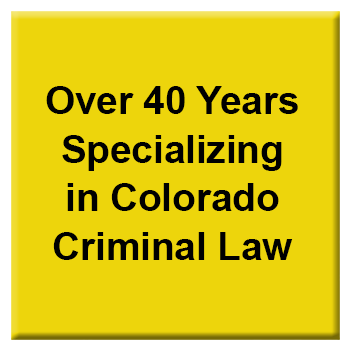 ABOUT THE AUTHOR: H. Michael Steinberg – Email The Author at:
ABOUT THE AUTHOR: H. Michael Steinberg – Email The Author at:
A Denver Colorado Criminal Defense Lawyer – or call his office at 303-627-7777 during business hours – or call his cell if you cannot wait and need his immediate assistance – please call 720-220-2277.
“A good criminal defense lawyer is someone who devotes themselves to their client’s case from beginning to end, always realizing that this case is the most important thing in that client’s life.”
You should be careful to make a responsible choice in selecting a Colorado Criminal Defense Lawyer. We encourage you to “vet” our firm. Over the last 40 plus years – by focusing ONLY on Colorado criminal law – H. Michael has had the necessary time to commit to the task of constantly updating himself on nearly every area of criminal law, to include Colorado criminal law and procedure and trial and courtroom practice. H. Michael works hard to get his clients the best possible results in and out of the courtroom. He has written, and continues to write, extensively on Colorado criminal law and he hopes this article helps you in some small way – When The Denver Police Seize Your Property As A Public Nuisance.
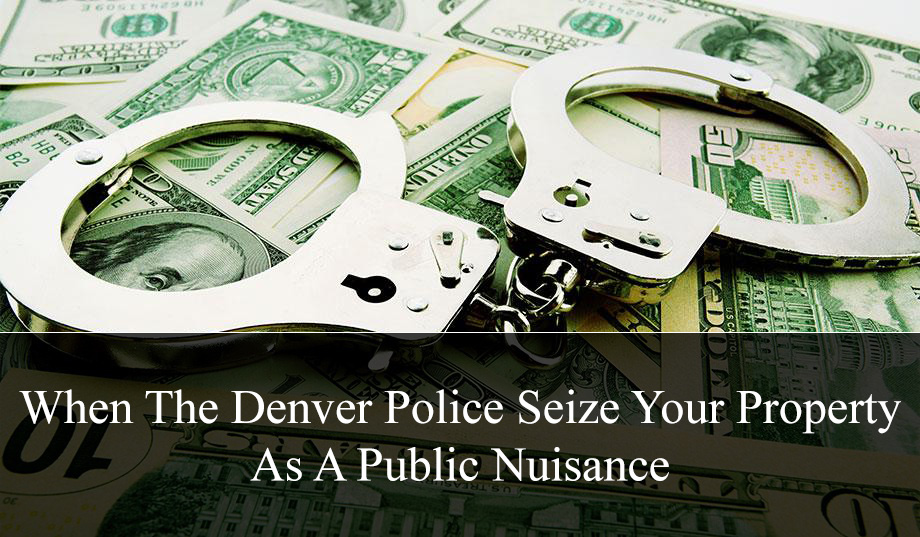
Other Articles of Interest:
- Search Warrants: How They Work
- If You Are Stopped for a Traffic Matter
- Stopped for a Traffic Matter
- FAQ: Colorado Law Automobile Searches
- 025. COLORADO CRIMINAL CODE – OFFENSES AGAINST PUBLIC PEACE, ORDER, AND DECENCY – HARASSMENT ETC

